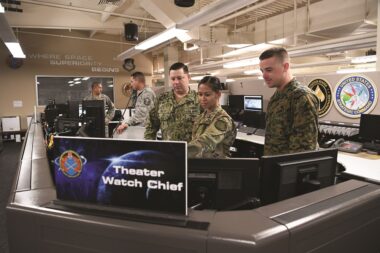The U.S. Space Force is eager to tap into the vibrant commercial market for space services enabled by increasingly capable small satellites and cheaper access to orbit.
Commercial services of particular interest to the military include imagery, analytics, weather data and broadband from low-Earth orbit constellations.
“It’s really crucial that we figure out how to successfully integrate commercial data and services into our architectures and concepts of operations,” said Lt. Gen. John Thompson, head of the Space and Missile Systems Center (SMC), the procurement arm of the Space Force.
The Space Force already is a major consumer of commercial space launch services and geostationary satellite communications but it is now looking to “go bigger and bolder,” Thompson said, calling this a matter of national security.

The military’s modernization plans increasingly depend on technologies funded by the private sector, Thompson noted. The Space Force is responsible for providing satellite-enabled capabilities to the entire Defense Department, and the acquisition of new space services will be a central piece of that effort.
The next step will be to organize a new office focused on the procurement of commercial space services. This office will be part of the future Space Systems Command, said Gen. David Thompson, the Space Force vice chief of space operations.
Space Systems Command will be established in Los Angeles later this year and will replace SMC. Thompson said the plan is to expand SMC’s existing commercial satellite communications services office so it can acquire other types of commercial capabilities.
One of those services will be “tactical ISR,” short for intelligence, surveillance and reconnaissance. Tactical ISR would support military units in the field that currently don’t have direct access to satellite imagery. Field commanders want visual imagery but also radar, radio-frequency and other types of data collected by Earth observation satellites that capture images in short time intervals.
CHANGE IN MINDSET
Col. Timothy Sejba, program executive officer for space development at SMC, said procuring commercial space services is a departure from the traditional business model where the military dictates requirements and contractors are paid to build systems owned by the government.
Buying commercial services means the Defense Department doesn’t have to finance the cost of building and operating a constellation, and simply acquires the data. This is a huge benefit, said Sejba, but there are risks that also have to be weighed.
To be sure, the Pentagon does not want to become entirely dependent on commercial providers that may or may not be able to support the military during an armed conflict. Sejba said the Space Force will not outsource critical “no fail” capabilities like satellite-based missile warning or Global Positioning System navigation.
The priority for SMC, he said, is to figure out a business model for how to access commercial services that would not replace, but supplement, government-owned capabilities.

Tactical ISR, weather data and broadband from low-orbiting constellations are the low-hanging fruit, he said. “We know there is an extensive commercial industry base we have to tap into, and augment with government unique capabilities only when commercial can’t fulfill.”
As plans move forward to stand up the new Space Systems Command, the most likely path to establish a commercial space services office will be to follow the model now used to acquire satellite communications.
CSCO, the Commercial Satellite Communications Office that reports to SMC but is located near Washington, is viewed as a template for how other services could be acquired but there are still many details to be worked out, Sejba said.
The satcom office buys $1 billion a year in commercial services and has built strong relationships with providers, he said. “We want to leverage that expertise.”
As the Space Force looks to buy more commercial services, Sejba said, one of the challenges will be market research, as SMC is not familiar with many of the new space ventures entering the field. Further, the government has to figure out how to use its buying power to incentivize companies that want the Defense Department as a customer but also have to prioritize the needs of a broader market.
Aerospace Corp., a nonprofit firm that provides technical services to DoD and other government agencies, plans to help SMC establish connections with space startups and new entrants, said Randy Kendall, vice president of launch and enterprise operations at Aerospace.
Before the Space Force commits to buying critical services from a new commercial provider, it will want to know, for example, who is funding the company and whether their systems are adequately protected against cyber threats, Kendall said. Aerospace would help screen potential suppliers to make sure they are technically and financially sound.
Aerospace also would facilitate SMC’s communications with venture investors to give them greater insight into the government’s wish lists so they can better target their investments, he said.

INVESTORS ENCOURAGED
Jordan Noone, co-founder and partner of Embedded Ventures, said investors in the space sector are encouraged by the Space Force’s talk about increasing reliance on commercial services. He said the idea of having a technical expert like Aerospace screen companies makes a lot of sense.
“I would be very excited to see an office set up that can evaluate companies in a quick turnaround manner,” he added. “This is something that we view as a necessity.”
Embedded Ventures was launched in November to focus on dual-use technology companies. CEO and co-founder Jenna Bryant and Noone recently met with SMC officials and discussed ways in which investors could help fund specific Space Force needs. “We are willing to help grow companies knowing that the government is sitting there waiting to be a customer,” Noone said.
Some of the companies that Embedded Ventures plans to fund are in the space infrastructure sector, said Noone. He said he could not identify them by name but they include providers of in-space communications and logistics, life extension vehicles and resource extraction.
Once the Space Force determines what its future needs will be for space infrastructure services, “we can help drive private investment to companies that can work with those complex requirements,” said Noone.
Mandy Vaughn, former president of launch provider Virgin Orbit’s government-focused VOX Space subsidiary and now a private consultant, said one of the obstacles for commercial providers is that the U.S. military has a tough time buying products or services “as is.”
Buying commercial services requires a different mindset, she said. The government is going to have to understand that it can’t change a commercial product but has to adjust its needs so it can take advantage of what’s available.
Vaughn said SMC leaders are “really thinking about this, which is kind of exciting.”
If the culture of how the military buys doesn’t change, she said, “then we’re going to be at a strategic disadvantage.” Leveraging the private investment that is going into space, said Vaughn, “is more than an opportunity. I think it should be a mandate.”

The space companies that are best equipped to provide services to the military are those that already have a healthy commercial customer base, said Tess Hatch, a partner at Bessemer Venture Partners.
“The government is a fabulous customer for any space startup, or any company, period,” she said. But for many companies that have not worked with the government before it can be a steep learning curve.
Many companies have gotten a taste of the government market working on Small Business Innovation Research (SBIR) contracts, Hatch noted. But transitioning from SBIR to full-scale services is “still difficult for our startups to navigate, even for our very large growth stage companies.
INTELLIGENCE, WEATHER DATA
The Space Force’s interest in commercial ISR could create significant opportunities for players in the geospatial intelligence industry that have demonstrated the capabilities of small satellites, said John Serafini, CEO of radio-frequency data analytics company HawkEye 360.
Constellations of remote-sensing smallsats deliver overhead imagery, radar and radio-frequency mapping to track objects or events, as well as analytics software to make sense of the data, said Serafini. “These capabilities didn’t exist five or 10 years ago.”
Indications that the Space Force will buy commercial ISR is “very exciting news” and sends a demand signal, he said. “There is now a bullpen of commercial companies that can service that.”
The Space Force can buy a subscription and receive data just like any other customer, said Serafini. And as industry investors continue to fund new capabilities, he said, the military will be able to rely on the commercial market to build the infrastructure using private capital.
Space startup ExoTerra Imaging is developing a constellation of cubesats to provide global cloud and weather imagery data. CEO David Crain noted that the Space Force relies on government-owned satellites for weather data but is now showing interest in commercial options to augment military systems.
ExoTerra Imaging plans to pitch its service to military users of weather data that need frequent updates on cloud movements so they can plan flight routes and satellite tasking, he said. “With a constellation of cubesats, we could update and refresh the cloud mask data as quickly as possible,” said Crain. “We see that as a potential business.”
Space Force initiatives to acquire commercial services are good news for the industry, said Crain, but it remains to be seen if the government is serious about working with emerging startups and ventures that are new to the game. “Sometimes small companies are told that they don’t have the right retired general on their board,” Crain said. “It’s that blunt.”
Commercial space companies have been waiting for the government to embrace the commercial services model, he said. “I’m confident that if you deliver a service that meets a need they will buy it, as long as the price is competitive.”
LEO BROADBAND
Another item on the Space Force’s wish list of commercial space services is broadband communications from low Earth orbit. SMC’s Commercial Satellite Communications Office procures broadband from operators of geostationary satellites and narrowband communications from longtime mobile satellite services provider Iridium Communications. The office is now looking to add LEO broadband providers, opening up opportunities for the likes of SpaceX, OneWeb, Telesat and others.
Satcom users across the military are demanding low-latency global communications and the Space Force is working to figure out how to procure these services, said Jiral Shah, program manager at CSCO.
The office earlier this year issued a request for information from LEO providers. The feedback is helping Space Force satcom buyers better understand the market before they issue contracts, said Shah.
“We want to be able to let the commercial marketplace play itself out, we don’t want to drive one company or one industry to either success or failure,” he said. “We just want to buy what is available and help support the warfighter’s mission.”
Satcom services are funded through a “defense working capital fund,” an accounting mechanism the Pentagon uses to fund specific activities, and functions like a checking account. CSCO customers, for example, deposit their payments for satcom services in the working fund.
The defense working capital fund used for satcom purchases would be a good model for how agencies could pay for other space services like imagery or analytics, said Air Force Brig. Gen. Steve Butow, who heads the Defense Innovation Unit’s space portfolio and has advocated for the adoption of commercial services.
Butow, who soon will be retiring from active-duty military service, said “nothing would make me happier before I retire than to see the Space Force be the executive agent for all commercial imagery and analytics.”
Ric VanderMeulen, Viasat’s vice president of government satcom, commended the Space Force for its enthusiasm with regard to commercial services. It’s a major shift in culture, he said.
“When you’re in the business of bespoke systems, you’re in the business of prescribing specifically what you want,” said VanderMeulen. “When you choose to buy a service that wasn’t built 100% for you, you have to adapt to what it is. You don’t get to prescribe how it works.”
This article originally appeared in the June 2021 issue of SpaceNews magazine.
#Space | https://sciencespies.com/space/military-building-an-appetite-for-commercial-space-services/
No comments:
Post a Comment